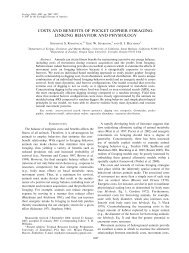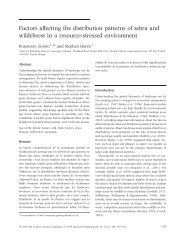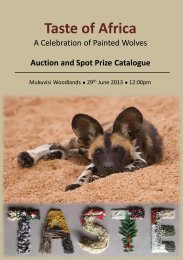The feeding ecology of the aardvark Orycteropus afer - ResearchGate
The feeding ecology of the aardvark Orycteropus afer - ResearchGate
The feeding ecology of the aardvark Orycteropus afer - ResearchGate
Create successful ePaper yourself
Turn your PDF publications into a flip-book with our unique Google optimized e-Paper software.
148 W. A. TAYLOR ET AL.prey species compared to 15 in <strong>the</strong> present study. Willis et al. (1992) found thatA. custodiens was present in all faecal samples, making up an average <strong>of</strong> 44% <strong>of</strong> <strong>the</strong> diet.Anoplolepis spp. occurred in 96% <strong>of</strong> faecal samples during <strong>the</strong> present study and madeup an average <strong>of</strong> 68% in <strong>the</strong> diet. <strong>The</strong> abundance <strong>of</strong> Anoplolepis spp. is <strong>the</strong> probablecause <strong>of</strong> <strong>the</strong>m being so common in <strong>the</strong> <strong>aardvark</strong>s diet.Trinervitermes trinervoides was <strong>the</strong> second most important prey species in <strong>the</strong> presentstudy, compared to third in that <strong>of</strong> Willis et al. (1992). <strong>The</strong> average proportions <strong>of</strong> totalnumbers were similar between <strong>the</strong> two studies (13)8% 1992 cf. 15)3% present) but <strong>the</strong>percentage occurrence was different (30% 1992 cf. 83% present). Willis et al.(1992) found H. mossambicus in every faecal deposit, compared to 44% occurrence in<strong>the</strong> present study.<strong>The</strong> differential contributions made by <strong>the</strong> latter two prey species during <strong>the</strong> twostudies may be explained by temporal and spatial mosaics in <strong>the</strong>ir distributions. <strong>The</strong>rewas a time lapse <strong>of</strong> 10 years between studies, while data were collected from differentsites within TdR. Ant and termite populations are known to have mosaic distributions(Samways, 1983) and this was shown to be <strong>the</strong> case at TdR (Lindsey & Skinner,2001).Seasonal variation in dietNumbers <strong>of</strong> A. custodiens are lowest between May and July (Steyn, 1954; Lindsey& Skinner, 2001) when developmental stages are virtually non-existent. This suggestssummer is a relatively good time to eat <strong>the</strong>m. However, no pattern <strong>of</strong> increased <strong>feeding</strong>on A. custodiens occurred in summer. This might be explained by two factors. First, eventhough A. custodiens numbers were low in winter, <strong>the</strong>y were actually high relative tonumbers <strong>of</strong> o<strong>the</strong>r ant species (Lindsey & Skinner, 2001). Secondly, <strong>the</strong>re was nodifference in <strong>the</strong> energy value <strong>of</strong> A. custodiens between seasons, making individualants just as valuable in winter.Trinervitermes trinervoides differ from Anoplolepis spp. in several ways. First, <strong>the</strong>ynest in hard mounds which require more effort to break into (pers. obs.). Secondly,large T. trinervoides mounds hold over 80,0000 termites (Adam, 1993), compared withA. custodiens nests which contain little over 1000 adult ants (Steyn, 1954). Thirdly,populations <strong>of</strong> adult T. trinervoides do not decrease significantly in winter months(Adam, 1993) so <strong>the</strong> number <strong>of</strong> termites per colony is not a limiting factor on predation.Trinervitermes trinervoides is a nocturnal forager (Adam, 1993), while A. custodiens ispredominantly diurnal (Steyn, 1954; Willis et al., 1992). Surface activity <strong>of</strong> T. trinervoidesvirtually ceases in winter (Adam, 1993) and <strong>the</strong>y are confined to <strong>the</strong>ir mounds. Inwarmer months <strong>the</strong> termites travel along shallow tunnels to foraging areas and are <strong>of</strong>teneaten out <strong>of</strong> <strong>the</strong>se.Calorific values <strong>of</strong> T. trinervoides workers and soldiers do not vary between seasons,nei<strong>the</strong>r do <strong>the</strong>ir overall numbers. However, calorific values and numbers <strong>of</strong> alates dovary. Alate production begins in March and by October <strong>the</strong>y are fully developed, withmaximum calorific value (Adam, 1993). <strong>The</strong> availability <strong>of</strong> alates might induce <strong>aardvark</strong>sto feed more from mounds in winter, but <strong>the</strong>re was no evidence for this becauseany ingested alates would have been fully digested due to <strong>the</strong>ir s<strong>of</strong>t bodies (Adam,1993).Trinervitermes trinervoides occurred in higher percentages in <strong>the</strong> faeces in winter when<strong>aardvark</strong>s fed from epigeal mounds. Aardvarks also eat T. trinervoides from foragingparties in summer, but as concentrations are higher in mounds, winter <strong>feeding</strong> predisposesa higher intake rate and possibly more termites eaten overall. This contradicts <strong>the</strong>findings <strong>of</strong> Melton (1976) and Willis et al. (1992), who found that termites were takenmore in summer than winter.





